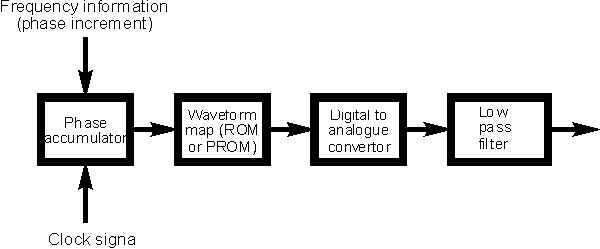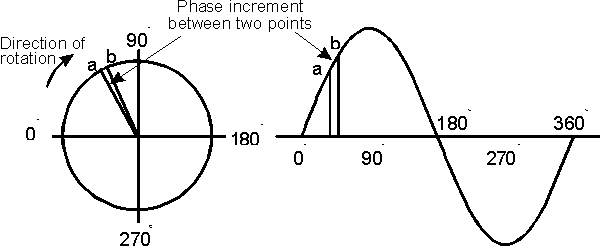Direct digital synthesis (DDS)
Direct digital synthesis (DDS) is a powerful technique used in the generation
of radio frequency signals for use in a variety of applications from radio
receivers to signals generators and many more. The technique has become far more
widespread in recent years with the advances being made in integrated circuit
technology that allow much faster speeds to be handled which in turn enable
higher frequency DDS chips to be made.
Although often used on its own, Direct Digital Synthesis is often used in
conjunction with indirect or phase locked loop synthesizer loops. By combining
both technologies it is possible to take advantage of the best aspects of each.
In view of the fact that integrated circuits are now widely available, this
makes them easy to use.
How it works
As the name suggests this form of synthesis generates the waveform directly
using digital techniques. This is different to the way in which the more
familiar indirect synthesizers that use a phase locked loop as the basis of
their operation.
A direct digital synthesizer operates by storing the points of a waveform in
digital format, and then recalling them to generate the waveform. The rate at
which the synthesizer completes one waveform then governs the frequency. The
overall block diagram is shown below, but before looking at the details
operation of the synthesizer it is necessary to look at the basic concept behind
the system.
The operation can be envisaged more easily by looking at the way that phase
progresses over the course of one cycle of the waveform. This can be envisaged
as the phase progressing around a circle. As the phase advances around the
circle, this corresponds to advances in the waveform.

Block Diagram of a Basic Direct Digital Synthesizer
(DDS).
The synthesizer operates by storing various points in the waveform in digital
form and then recalling them to generate the waveform. Its operation can be
explained in more detail by considering the phase advances around a circle as
shown in Figure 2. As the phase advances around the circle this corresponds to
advances in the waveform, i.e. the greater the number corresponding to the
phase, the greater the point is along the waveform. By successively advancing
the number corresponding to the phase it is possible to move further along the
waveform cycle.
The digital number representing the phase is held in the phase accumulator.
The number held here corresponds to the phase and is increased at regular
intervals. In this way it can be sent hat the phase accumulator is basically a
form of counter. When it is clocked it adds a preset number to the one already
held. When it fills up, it resets and starts counting from zero again. In other
words this corresponds to reaching one complete circle on the phase diagram and
restarting again.

Operation of the phase accumulator in a direct digital
synthesizer.
Once the phase has been determined it is necessary to convert this into a
digital representation of the waveform. This is accomplished using a waveform
map. This is a memory which stores a number corresponding to the voltage
required for each value of phase on the waveform. In the case of a synthesizer
of this nature it is a sine look up table as a sine wave is required. In most
cases the memory is either a read only memory (ROM) or programmable read only
memory (PROM). This contains a vast number of points on the waveform, very many
more than are accessed each cycle. A very large number of points is required so
that the phase accumulator can increment by a certain number of points to set
the required frequency.
The next stage in the process is to convert the digital numbers coming from
the sine look up table into an analogue voltage. This is achieved using a
digital to analogue converter (DAC). This signal is filtered to remove any
unwanted signals and amplified to give the required level as necessary.
Tuning is accomplished by increasing or decreasing the size of the step or
phase increment between different sample points. A larger increment at each
update to the phase accumulator will mean that the phase reaches the full cycle
value faster and the frequency is correspondingly high. Smaller increments to
the phase accumulator value means that it takes longer to increase the full
cycle value and a correspondingly low value of frequency. In this way it is
possible to control the frequency. It can also be seen that frequency changes
can be made instantly by simply changing the increment value. There is no need
to a settling time as in the case of phase locked loop based synthesizer.
From this it can be seen that there is a finite difference between one
frequency and the next, and that the minimum frequency difference or frequency
resolution is determined by the total number of points available in the phase
accumulator. A 24 bit phase accumulator provides just over 16 million points and
gives a frequency resolution of about 0.25 Hz when used with a 5 MHz clock. This
is more than adequate for most purposes.
These synthesizers do have some disadvantages. There are a number of spurious
signals which are generated by a direct digital synthesizer. The most important
of these is one called an alias signal. Here images of the signal are generated
on either side of the clock frequency and its multiples. For example if the
required signal had a frequency of 3 MHz and the clock was at 10 MHz then alias
signals would appear at 7 MHz and 13 MHz as well as 17 MHz and 23 MHz etc..
These can be removed by the use of a low pass filter. Also some low level
spurious signals are produced close in to the required signal. These are
normally acceptable in level, although for some applications they can cause
problems.
|

